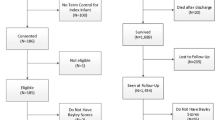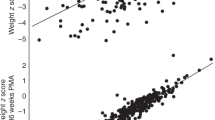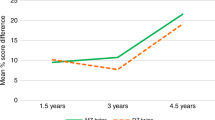Abstract
Background
Neurodevelopmental trajectories of preterm children may have changed due to changes in care and in society. We aimed to compare neurodevelopmental trajectories in early and moderately late preterm children, measured using the Developmental (D)-score, in two cohorts born 15 years apart.
Methods
We included early preterm and moderately late preterm children from two Dutch cohorts (LOLLIPOP, 2002–2003 and ePREM, 2016–2017). ePREM counterparts were matched to LOLLIPOP participants by gestational age and sex. D-score trajectories were summarized by a multilevel model with random intercepts and random slopes, and multigroup analyses were used to test if the intercepts and slopes differed across cohorts.
Results
We included 1686 preterm children (1071 moderately late preterm, 615 early preterm) from LOLLIPOP, and matched these with 1686 ePREM counterparts. The neurodevelopmental trajectories of the two cohorts were mostly similar. For early preterm children, we found no statistically significant differences. For moderately late preterm children, both the intercept (43.0 vs. 42.3, p < 0.001) and slope (23.5 vs. 23.9, p = 0.002) showed some, but only clinically minor, differences.
Conclusion
Developmental trajectories, measured using the D-score, in the first four years of life are comparable and stable across a period of 15 years for both early and moderately late preterm children.
Impact
-
Neurodevelopmental trajectories are similar for early and moderately late preterm children born 15 years apart and thus seem quite stable in time.
-
The validated Developmental score visualizes these trajectories based on developmental milestone attainment
-
Because of its stability over time, the Developmental score trajectory may aid clinicians in neurodevelopmental assessment of preterm children as this simplifies monitoring and interpretation, similar to a growth chart.
This is a preview of subscription content, access via your institution
Access options
Subscribe to this journal
Receive 14 print issues and online access
$259.00 per year
only $18.50 per issue
Buy this article
- Purchase on Springer Link
- Instant access to full article PDF
Prices may be subject to local taxes which are calculated during checkout


Similar content being viewed by others
References
Chawanpaiboon, S. et al. Global, regional, and national estimates of levels of preterm birth in 2014: a systematic review and modelling analysis. Lancet Glob. Health 7, e37–e46 (2019).
Johnson, S. & Marlow, N. Early and long-term outcome of infants born extremely preterm. Arch. Dis. Child 102, 97–102 (2017).
Johnson, S. Cognitive and behavioural outcomes following very preterm birth. Semin. Fetal Neonatal Med. 12, 363–373 (2007).
Bos, A. F. & Roze, E. Neurodevelopmental outcome in preterm infants. Dev. Med. Child Neurol. 53, 35–39 (2011).
de Kieviet, J. F., Piek, J. P., Aarnoudse-Moens, C. S. & Oosterlaan, J. Motor development in very preterm and very low-birth-weight children from birth to adolescence: a meta-analysis. JAMA 302, 2235–2242 (2009).
Aarnoudse-Moens, C. S. H., Weisglas-Kuperus, N., van Goudoever, J. B. & Oosterlaan, J. Meta-analysis of neurobehavioral outcomes in very preterm and/or very low birth weight children. Pediatrics 124, 717–728 (2009).
Johnson, S. et al. Neurodevelopmental outcomes following late and moderate prematurity: a population-based cohort study. Arch. Dis. Child Fetal Neonatal Ed. 100, F301–F308 (2015).
de Jong, M., Verhoeven, M. & van Baar, A. L. School outcome, cognitive functioning, and behaviour problems in moderate and late preterm children and adults: a review. Semin. Fetal Neonatal Med. 17, 163–169 (2012).
Potijk, M. R., de Winter, A. F., Bos, A. F., Kerstjens, J. M. & Reijneveld, S. A. Higher rates of behavioural and emotional problems at preschool age in children born moderately preterm. Arch. Dis. Child 97, 112–117 (2012).
Cserjesi, R. et al. Functioning of 7-year-old children born at 32 to 35 weeks’ gestational age. Pediatrics 130, e838–e846 (2012).
Kerstjens, J. M. et al. Developmental delay in moderately preterm-born children at school entry. J. Pediatr. 159, 92–98 (2011).
Spittle, A. J., Orton, J., Doyle, L. W., Boyd, R. Early developmental intervention programs post hospital discharge to prevent motor and cognitive impairments in preterm infants. Cochrane Database Syst. Rev. 2015, CD005495 (2015).
Kynø, N. M. et al. Effect of an early intervention programme on development of moderate and late preterm infants at 36 months: a randomized controlled study. Infant Behav. Dev. 35, 916–926 (2012).
Van Hus, J. et al. Early intervention leads to long-term developmental improvements in very preterm infants, especially infants with bronchopulmonary dysplasia. Acta Paediatr. 105, 773–781 (2016).
Frankenburg, W. K., Dodds, J., Archer, P., Shapiro, H. & Bresnick, B. The denver II: a major revision and restandardization of the denver developmental screening test. Pediatrics 89, 91–97 (1992).
Kerstjens, J. M. et al. Support for the global feasibility of the ages and stages questionnaire as developmental screener. Early Hum. Dev. 85, 443–447 (2009).
Weber, A. M. et al. The D-score: a metric for interpreting the early development of infants and toddlers across global settings. BMJ Glob. Health 4, e001724 (2019).
Hornman, J., de Winter, A. F., Kerstjens, J. M., Bos, A. F. & Reijneveld, S. A. Stability of developmental problems after school entry of moderately late preterm and early preterm-born children. J. Pediatr. 187, 73–79 (2017).
van Noort-van der Spek, I. L., Dudink, J., Reiss, I. K. M. & Franken, M. C. J. P. Early speech sound production and its trajectories in very preterm children from 2 to 4 years of age. J. Speech Lang. Hear Res. 65, 1294–1310 (2022).
Jacobusse, G., van Buuren, S. & Verkerk, P. H. An interval scale for development of children aged 0-2 years. Stat. Med. 25, 2272–2283 (2006).
R Foundation for Statistical Computing. R: a language and environment for statistical computing. [Computer Program], 2020; version 4.0.2.
Muthen, L. K. & Muthen, B. Mplus user’s guide: Statistical analysis with latent variables, (2017). Available from: https://www.statmodel.com/download/usersguide/Mplus%20user%20guide%20Ver_7_r6_web.pdf.
Moore, T. et al. Neurological and developmental outcome in extremely preterm children born in england in 1995 and 2006: the EPICure studies. BMJ 345, e7961 (2012).
van Beek, P. E. et al. Developmental trajectories in very preterm born children up to 8 years: a longitudinal cohort study. Front Pediatr. 9, 672214 (2021).
Doyle, L. W., Robert, G. & Anderson, P. J. Outcomes at age 2 years of infants < 28 weeks’ gestational age born in victoria in 2005. J. Pediatr. 156, 49–53.e1 (2010).
Cheong, J. L. Y. et al. Changing neurodevelopment at 8 years in children born extremely preterm since the 1990s. Pediatrics 139, e20164086 (2017).
Stoll, B. J. et al. Trends in care practices, morbidity, and mortality of extremely preterm neonates, 1993-2012. JAMA 314, 1039–1051 (2015).
Adams-Chapman, I. et al. Neurodevelopmental impairment among extremely preterm infants in the neonatal research network. Pediatrics 141, e20173091 (2018).
Pierrat, V. et al. Neurodevelopmental outcome at 2 years for preterm children born at 22 to 34 weeks’ gestation in france in 2011: EPIPAGE-2 cohort study. BMJ 358, e3448 (2017).
Santhakumaran, S. et al. Survival of very preterm infants admitted to neonatal care in England 2008-2014: Time trends and regional variation. Arch. Dis. Child Fetal Neonatal Ed. 103, F208–F215 (2018).
Potijk, M. R., Kerstjens, J. M., Bos, A. F., Reijneveld, S. A. & de Winter, A. F. Developmental delay in moderately preterm-born children with low socioeconomic status: risks multiply. J. Pediatr. 163, 1289–1295 (2013).
Acknowledgements
This study was part of a larger study on the growth and development of preterm children. We wish to thank the participating preventive child healthcare PCHC physicians for their contribution to the fieldwork. In particular, we thank Drs. E.M.J. ten Vergert, M. Broer van Dijk, and B. van der Hulst for coordinating the project. We are grateful to the ePREM research group for their contribution to this cohort study. Finally, we thank Dr. J. Almansa for his assistance in the statistical analyses.
Funding
LOLLIPOP was supported by grants from the research foundation of Beatrix Children’s Hospital, the Cornelia Foundation for the Handicapped Child, and the research fund of A. Bulk-Child Preventive Child Health Care, Dutch Brain Foundation, and unrestricted investigator-initiated research grants from FrieslandCampina, Friso Infant Nutrition, and Pfizer Europe. The financiers had no role at any stage of the project, including the decision to submit the manuscript. ePREM was supported by a grant from ZonMw (grant 70-73600-98-519).
Author information
Authors and Affiliations
Contributions
Ms. van Dokkum N.H. assisted in the data handling and statistical analyses and drafted the initial manuscript. Mr. Lepe A. performed the data handling, data visualizations, and statistical analyses. Prof van Buuren S. conceptualized and designed the D-score and performed part of the statistical analyses. Prof Reijneveld S.A. conceptualized and designed the LOLLIPOP study and data handling. Prof de Kroon M.L.A. conceptualized and designed the ePREM study and data handling and supervised the execution of the LOLLIPOP and ePREM studies. All authors critically reviewed and revised the manuscript and approved the final manuscript as submitted and agree to be accountable for all aspects of the work.
Corresponding author
Ethics declarations
Competing interests
The authors declare no competing interests.
Consent statement
The LOLLIPOP study was approved by the Institutional Review Board of the University Medical Center Groningen (METc 2005/130), and written informed consent was provided by all parents.
Additional information
Publisher’s note Springer Nature remains neutral with regard to jurisdictional claims in published maps and institutional affiliations.
Rights and permissions
Springer Nature or its licensor (e.g. a society or other partner) holds exclusive rights to this article under a publishing agreement with the author(s) or other rightsholder(s); author self-archiving of the accepted manuscript version of this article is solely governed by the terms of such publishing agreement and applicable law.
About this article
Cite this article
van Dokkum, N.H., Lepe, A., van Buuren, S. et al. Stability of neurodevelopmental trajectories in moderately late and early preterm children born 15 years apart. Pediatr Res (2024). https://doi.org/10.1038/s41390-024-03188-2
Received:
Revised:
Accepted:
Published:
DOI: https://doi.org/10.1038/s41390-024-03188-2



